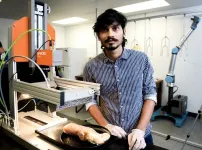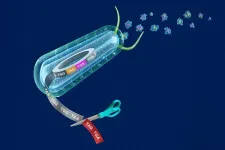(Press-News.org) DURHAM, N.C. -- The world’s largest known lithium deposit exists within a vast salt pan called the Salar de Uyuni, which stretches for thousands of square miles atop a high, dry Andean plateau in Bolivia. For most of the year, salt crystals encrust the terrain, white as confectioner’s sugar. During the wet season, pooling rainwater mirrors surrounding mountains and sky.
“The Salar is a magical place for travelers from all over the world who come to see the colors, the reflections, in this endless white landscape,” said Avner Vengosh, Nicholas Chair of Environmental Quality at the Duke University Nicholas School of the Environment.
What most tourists don’t see is the vast reserve of lithium dissolved in highly saline, or salty, brine just below their shoes. Contained within sediments and salts that descend a few feet to more than 160 feet below the surface, this untapped trove could potentially be a key resource for the renewable energy sector.
For the past few years, Vengosh, who is also chair of the Division of Earth and Climate Sciences at the Nicholas School, and Ph.D. student Gordon Williams have been working to understand the potential environmental health implications of lithium mining, both in the U.S. and abroad.
Reporting in Environmental Science & Technology Letters in January, the duo conducted the first thorough chemical analysis of wastewater associated with mining the lithium brine at the Salar de Uyuni. Their findings could inform strategies to manage future mining operations more sustainably and protect the fragile salar environment.
Lithium-brine mining currently entails a multi-step process that generally goes like this: Brine is pumped from below the surface into a series of shallow, above-ground evaporation ponds. As liquid evaporates in successive ponds, undesirable salts precipitate out. Lithium, however, becomes more concentrated in the brine at each stage. The concentrated lithium is eventually moved from the evaporation ponds to a nearby facility for processing into lithium carbonate — the material that goes into rechargeable batteries.
Lithium extraction at the Salar de Uyuni is in preliminary stages. However, research has shown that long-term mining of lithium brines in other salt pans, such as the Salar de Atacama in Chile, can cause groundwater levels to decline and land to subside, or sink. Such impacts could affect the future of lithium mining at the Salar de Uyuni, according to Vengosh.
For their study, Williams and Vengosh analyzed the chemistry of lithium brine and waste materials associated with a pilot mining operation at the Salar de Uyuni. In particular, they were interested in determining acidity and presence of trace elements, such as arsenic, a toxic metal that can cause a range of health problems in exposed people and wildlife. Samples from the mine site included natural brine pumped from underground; brine from eight evaporation ponds; and wastewater from the lithium processing facility.
In natural brine samples, the team measured arsenic levels between 1 and 9 parts per million, as well as relatively neutral acidity. In comparison, evaporation pond brine became increasingly acidic as it became more concentrated.
Arsenic levels also dramatically increased from pond to pond. For example, the last pond revealed arsenic levels at nearly 50 parts per million — about 1,400 times higher than the benchmark considered ecologically acceptable by the U.S. Environmental Protection Agency.
“This arsenic level is extremely high,” Vengosh remarked. “My group has worked all over the world — in Africa, Europe, Vietnam, India — and I don’t think we ever measured that level of arsenic.”
As the authors noted, leaking or intentional discharge of brine from the evaporation ponds to the surrounding salt pan could negatively affect wildlife.
“There’s a risk for bioaccumulation,” said Williams, referring to the process by which chemicals build up in organisms over time, with potentially harmful consequences. Flamingos, for instance, feed on local brine shrimp, which are sensitive to arsenic at levels above 8 parts per million.
The team also found that levels of boron — which can potentially cause health effects depending on the nature of exposure — increased from evaporation pond to evaporation pond. By contrast, wastewater from the lithium processing plant showed relatively low levels of boron and arsenic similar to, and in some cases lower than, levels found in the natural brines.
Additionally, Williams and Vengosh investigated the potential repercussions of taking spent brine — that is, brine left over after lithium is removed — or wastewater from lithium processing and injecting it back into the lithium deposit. The lithium-mining industry has indicated these approaches can counteract land subsidence.
The team found that both injection methods would have undesirable consequences. For example, the spent brine would likely mix poorly with natural brine, hindering the flow of brine below the surface and potentially interfering with pumping. On the other hand, injecting wastewater back into the deposit could dilute the lithium resource.
One potential solution to preventing land subsidence would be to carefully blend spent brine with wastewater to achieve a chemical balance with the natural brine, the authors indicated. However, future studies should further investigate the environmental implications of that strategy, they added.
For their part, Williams and Vengosh are turning their attention to the origin of lithium at the Salar de Uyuni.
“We’re building a geochemical model to understand why lithium is enriched in those brines,” Williams explained. “What’s the source? And what’s the mechanism causing this concentration?”
Additionally, Williams, Vengosh and Ph.D. student Hannah Wudke are working with another Nicholas School team — led by John O. Blackburn Distinguished Professor Erika Weinthal — to understand how lithium-brine mining at the Salar de Uyuni could affect the health and well-being of neighboring Indigenous communities.
“We see lithium as the future for energy security, so we’re trying to analyze it from different angles to ensure sustainable development and supplies,” Vengosh said.
_________________________________________________________________________________________
Funding: This study was supported by the Duke University Climate Research Innovation Seed Program (CRISP), the Duke University Josiah Charles Trent Memorial Foundation Endowment Fund, and the Duke University Graduate School Dissertation Research Travel Award.
Citation: “Quality of Wastewater from Lithium-Brine Mining,” Gordon D. Z. Williams and Avner Vengosh. Environmental Science & Technology Letters, Jan. 17, 2025, DOI: 10.1021/acs.estlett.4c01124
Online link: https://pubs.acs.org/doi/full/10.1021/acs.estlett.4c01124
END
Examining the potential environmental effects of mining the world’s largest lithium deposit
2025-02-11
ELSE PRESS RELEASES FROM THIS DATE:
Chicken ‘woody breast’ detection improved with advanced machine learning model
2025-02-11
FAYETTEVILLE, Ark. — It’s called “woody breast” and for consumers it can mean a chewier chicken sandwich, but for the industry it can mean up to $200 million annual yield loss.
Work done by the Arkansas Agricultural Experiment Station is not only making woody breast easier to detect in chicken meat but is accurate up to 95 percent of the time.
The development could help improve quality assurance and customer confidence in one of the state’s most economically important agricultural products. What allows ...
Around 1 in 5 UK medical students considers dropping out, study suggests
2025-02-11
Around 1 in 5 UK medical students considers dropping out of medical school, with mental health issues a key contributor to their intention to abandon medicine, suggest the results of an observational study published in the open access journal BMJ Open.
The shortage of doctors worldwide is a major cause for concern, say the researchers, with the current shortfall thought to be around 6.5 million.
These shortages not only affect the quality of patient care, but also doctors’ wellbeing as a result of increased workload and chronic stress, which further undermine recruitment and retention, creating a vicious circle, they add.
Given that medical ...
Poor childhood social and cognitive skills combo linked to teens’ poor exam results
2025-02-11
The combination of poorly developed social and cognitive skills during childhood is linked to poor exam results by the age of 16, with those for whom these issues persist throughout their childhood more than 4 times as likely not to pass at least 5 GCSEs, finds research published online in the Archives of Disease in Childhood.
The findings, which are based on a large set of nationally representative data, suggest that childhood cognitive and behavioural issues may be behind 17% of GCSE (General Certificate of Secondary Education) exam fails among 16 year olds, conclude the researchers.
“Years in school matter, not just for exam results, but for skills and capacity development. ...
Position menstrual cups carefully to avoid possible kidney problems, doctors urge
2025-02-11
A poorly positioned menstrual cup to capture monthly blood flow may lead to more serious complications than leakage alone, warn doctors in the journal BMJ Case Reports, after treating a young woman with uterohydronephrosis—a swollen kidney caused by blocked urine flow into the bladder.
The use of menstrual cups as a sustainable alternative to other methods of controlling period blood flow is rising, note the report authors. While reported complications are rare, the evidence suggests that pain, vaginal wounds, allergic reactions, ...
Yale scientists recode the genome for programmable synthetic proteins
2025-02-10
New Haven, Conn. — Synthetic biologists from Yale were able to re-write the genetic code of an organism — a novel genomically recoded organism (GRO) with one stop codon — using a cellular platform that they developed enabling the production of new classes of synthetic proteins. These synthetic proteins, researchers say, offer the promise of innumerable medical and industrial applications that can benefit society and human health.
The creation of the landmark GRO, known as “Ochre” — which fully compresses redundant, or “degenerate” codons, into a single codon — is ...
MiR-128-3p mediates MRP2 internalization in estrogen-induced cholestasis through targeting PDZK1
2025-02-10
https://www.scienceopen.com/hosted-document?doi=10.15212/AMM-2024-0053
Announcing a new publication for Acta Materia Medica journal. Estrogens have been reported to cause dysfunction in biliary transport systems, thereby inducing cholestasis. Multidrug resistance-associated protein 2 (MRP2) is a transporter responsible for independent bile flow. Emerging evidence indicates that PDZ domain containing 1 (PDZK1) regulates localization of MRP2; however, PDZK1’s role and regulatory machinery in MRP2-mediated estrogen-induced cholestasis (EIC) remain unclear.
The authors of this article observed, in a mouse model of EIC, downregulated PDZK1 expression in the liver and enhanced intracellular ...
Bleeding risk with apixaban and dabigatran similar to aspirin
2025-02-10
Embargoed for release until 5:00 p.m. ET on Monday 10 February 2025
@Annalsofim
Below please find summaries of new articles that will be published in the next issue of Annals of Internal Medicine. The summaries are not intended to substitute for the full articles as a source of information. This information is under strict embargo and by taking it into possession, media representatives are committing to the terms of the embargo not only on their own behalf, but also on behalf of the organization they represent.
----------------------------
1. ...
MD Anderson Research Highlights for February 10, 2025
2025-02-10
HOUSTON ― The University of Texas MD Anderson Cancer Center’s Research Highlights showcases the latest breakthroughs in cancer care, research and prevention. These advances are made possible through seamless collaboration between MD Anderson’s world-leading clinicians and scientists, bringing discoveries from the lab to the clinic and back. This issue includes studies to be presented this week at the 2025 American Society of Clinical Oncology (ASCO) Genitourinary Cancers Symposium.
Metastasis-directed therapy shows favorable ...
Ready (or not) for love? Your friends likely agree
2025-02-10
MSU has a satellite uplink/LTN TV studio and Comrex line for radio interviews upon request.
EAST LANSING, Mich. – Feeling ready for a committed relationship is a key step in dating. But do your friends agree that you’re ready for a long-term relationship? As this week is Valentine’s Day, newer couples may be considering just how serious their relationship is together.
A new study from Michigan State University found that friends significantly agreed on who was ready for committed relationships — and who wasn’t.
The ...
Health care students and clinicians support integrated care education
2025-02-10
Integrated care – a coordinated approach that addresses patients’ physical, mental and social health needs – has been shown to improve patient outcomes, reduce health care costs and address health disparities.
Since 2019, the Rutgers University Behavioral Health Care’s Center for Integrated Care has served as a hub for integrated care education and training at Rutgers Health while providing clinical services with partners throughout New Jersey.
Researchers at the center have published ...




